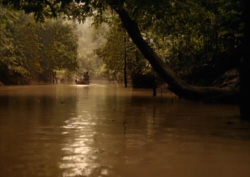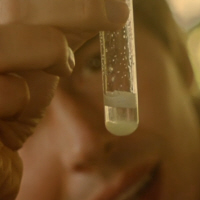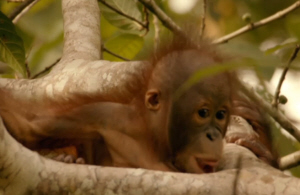Mystical Spark
Sabah, Malaysia
What is Life?

Sabah, Malaysia
This is the Malaysians state of Sabah, on the northern tip of the island of Borneo. It's one of the most bio-diverse places on the planet. Home to
15,000 plant species… 3000 species of tree… 420 species of bird… And 222 species of mammals.
Borneo's rainforests contain trees that are thought to live for more than 1,000 years.
But the forest itself has existed for tens of millions of years. The reason it persists is because each generation of animal and plant passes the
information to recreate itself onto the next generation. And that's possible because of a molecule found in every cell of every living thing. A molecule
called DNA.
Now, all I need to isolate my DNA is some washing up liquid, a bit of salt, and the chemist's best friend, vodka. Now, to get a sample of DNA I can
just use myself. If I just swill my tongue around on the edge of my cheek, I'll dislodge some cheek cells into my saliva.
There we are. A physicist doing an experiment. Then I add a bit of washing up liquid. Now, what this will do as it will break open those cheek cells
and it will also degrade the membrane that surrounds the cell nucleus that contains the DNA.
Salt will encourage the molecules to clump together.

DNA Sample
DNA is insoluble in alcohol. So you should get a layer of alcohol with the DNA molecule is precipitated out. Yeah. there, can you see? Those strands
of white. And so in that cloudy, almost innocuous looking solid are all the instructions needed to build a human being. So that is what makes life unique.
Only living things have the ability to encode and transmit information in this way. And the consequences of that profoundly affect our understanding
of what it is to be alive.
This rainforest is part of the Sepilok Forest reserve, and in here somewhere are some of our closest genetic relatives. There, can you see? Orang-utans
are highly specialised for life living in the forest canopy. Their arms are twice as long as their legs. And all four limbs are incredibly flexible.
Each one ending any hand whose curved bones are perfectly adapted for gripping branches.
These adaptations have encoded in information passed down in their DNA. This is the Orang-utan's genetic code. It was published in 2011, and there are
over 3 billion letters in it. If I flip through it… look at that. Now, it's composed of only four letters, A, C, T and G, which are known as bases.
They're chemical compounds. They are molecules. And the way it works is beautifully simple. There are grouped into threes, called codons, and some of
them just tell the code reader, if you like, how to start, or where to start and when… and when it's going to stop. In between, each group of three
codes for a particular amino acid. Now, amino acids are the building blocks of proteins, which are the building blocks of all living things. So you
would just read along, you'd find, start, stop, and then you go along in threes, build amino acid, build amino acid, stitch those together into a
protein, and if you keep doing that, eventually you'll come out with one of the those. Pointing at the Orang-utan. It's not that simple of course.
But the basics are there.
This code, written in there, are the instructions to make him. To faithfully reproduce those instructions for generation after generation, the
Orang-utans and, indeed all life on Earth, rely on a remarkable property of DNA. It's incredible stability and resistance to change. Every time a
cell divides, its DNA must be copied. And the genetic code is highly resistant to copying errors. The little enzymes, the chemical machines that
do the copying, on average make only one mistake in a billion letters. I mean, that's like copping out the Bible about 280 times and making just
one mistake.

Orang-Utan Infant
That fidelity means adaptations are faithfully transmitted from parent to offspring. And so while we think of evolution as a process of constant
change, in fact the vast majority of the code is preserved. So even though we are separated from the Orang-utans by nearly 14 million years of
evolution, what's really striking is just how similar we are. And those similarities are far more than skin deep. Orang-utans are surely one of
the most human of animals. And they share many behavioural traits that you would define as being uniquely human. They nurture their young for 8
years before they let them go on their own into the forest. In that time the infants learn which fruits are safe to eat and which are poisonous.
Which branches will hold their weight and which won't. And they can do all that because they have a memory, they can remember things that
happened to them in their life, they can learn from them, and they can pass them on from generation to generation.
And that deep connection extends far beyond our closest relatives. Because our DNA contains the fingerprint of almost 4 billion years of evolution.
If I draw a tree of life for the primates, then we share a common ancestor with the chimps, bonobos. About 4 to 6 million years ago. And if you
compare our genetic sequences you find that our genes are 99% the same. You go back to the split with gorillas, about 6 to 8 million years ago and
again, if you compare our genes you find that they are 98.4% the same. Back in time again, common ancestor with our friends over there, the
orang-utans, then our genes are 97.4% in the same. and you could carry on all the way back in time. You could look for our common ancestor with
a chicken, and you'd find that our codes at about 60% the same. And in fact, if you look for any animal, like him, or a little fly, or a bacteria,
something that seems superficially completely unrelated to us, then you will still find sequences in the genetic code which are identical to
sequences in my cells.
So this tells us that all life on Earth is related, it's all connected through our genetic code.

Fungi
DNA is the blueprint for life. But it's extraordinary fidelity means it also contains a story. And what a story it is. The entire history of
evolution from the present day all the way back to the very first spark of life. And it tells us that we are connected, not only to every plant
and animal alive today, but to every single thing that has ever lived.
The question, what is life, is surely one of the grandest of questions. And we've learnt that life isn't really a thing at all. It's a collection
of chemical processes that can harness a flow of energy to create local islands of order, like me and this forest, by borrowing order from the wider
universe and then transmitting it from generation to generation through the elegant chemistry of DNA. And the origins of that chemistry can be traced
back 4 billion years, most likely to vents in the primordial ocean. And, most wonderfully of all, the echoes of that history, stretching back for a
third of the age of the universe, can be seen in every cell of every living thing on Earth. And that leads to what I think is the most exciting
idea of all, because far from being some chance event ignited by a mystical spark, the emergence of life on Earth might have been an inevitable
consequence of the laws of physics. And if that's true, then a living cosmos might be the only way our cosmos can be.



